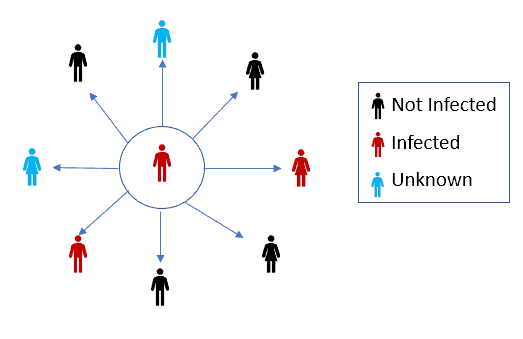May 10, 2020
By: Staff
In public health, contact tracing is the process of identification of persons who may have come into contact with an infected person (“contacts”) and subsequent collection of further information about these contacts. By tracing the contacts of infected individuals, testing them for infection, treating the infected, and tracing their contacts in turn, public health aims to reduce infections in the population. Diseases for which contact tracing is commonly performed for include tuberculosis, vaccine-preventable infections like measles, sexually transmitted infections (including HIV), blood-borne infections, some serious bacterial infections, and novel infections (e.g. SARS-CoV and SARS-CoV-2). The goals of contact tracing are:
- To interrupt ongoing transmission and reduce spread of an infection
- To alert contacts to the possibility of infection and offer preventive counseling or prophylactic care
- To offer diagnosis, counseling and treatment to already infected individuals
- If the infection is treatable, to help prevent reinfection of the originally infected patient
- To learn about the epidemiology of a disease in a particular population

Contact tracing has been a pillar of communicable disease control in public health for decades. The eradication of smallpox, for example, was achieved not by universal immunization, but by exhaustive contact tracing to find all infected persons. This was followed by isolation of infected individuals and immunization of the surrounding community and contacts at-risk of contracting smallpox.
In cases of diseases of uncertain infectious potential, contact tracing is also sometimes performed to learn about disease characteristics, including infectiousness. Contact tracing is not always the most efficient method of addressing infectious disease.
In areas of high disease prevalence, screening or focused testing may be more cost-effective.
Partner notification, also called partner care, is a subset of contact tracing aimed specifically at informing sexual partners of an infected person and addressing their health needs.
Steps in contact tracing
Contact tracing generally involves the following steps:
- An individual is identified as having a communicable disease (often called the index case). This case may be reported to public health or managed by the primary health care provider.
- The index case is interviewed to learn about their movements, whom they have been in close contact with, or who their sexual partners have been.
- Depending on the disease and the context of the infection, family members, health care providers, and anyone else who may have knowledge of the case’s contacts may also be interviewed.
- Once contacts are identified, public health workers contact them to offer counseling, screening, prophylaxis, and/or treatment.
- Contacts may be isolated (e.g. required to remain at home) or excluded (e.g. prohibited from attending a particular location, like a school) if deemed necessary for disease control.
- If contacts are not individually identifiable (e.g. members of the public who attended the same location), broader communications may be issued, like media advisories.
Although contact tracing can be enhanced by letting patients provide information, medication, and referrals to their contacts, evidence demonstrates that direct public health involvement in the notification is most effective.
Now that contact tracing is explained, we want to know your thoughts on this process to reduce the spread of COVID-19.
[yop_poll id=”3″]
